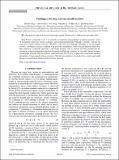| dc.contributor.author | Ding, Zhiwei | |
| dc.contributor.author | Zhou, Jiawei | |
| dc.contributor.author | Song, Bai | |
| dc.contributor.author | Li, Mingda | |
| dc.contributor.author | Liu, Te Huan | |
| dc.contributor.author | Chen, Gang | |
| dc.date.accessioned | 2018-11-20T15:39:03Z | |
| dc.date.available | 2018-11-20T15:39:03Z | |
| dc.date.issued | 2018-11 | |
| dc.date.submitted | 2018-10 | |
| dc.identifier.issn | 2469-9950 | |
| dc.identifier.issn | 2469-9969 | |
| dc.identifier.uri | http://hdl.handle.net/1721.1/119224 | |
| dc.description.abstract | Since Peierls's pioneering work, it is generally accepted that phonon-phonon scattering processes consist of momentum-conserving normal scatterings and momentum-destroying Umklapp scatterings, and that the latter always induce thermal resistance. We show in this work that Umklapp scatterings are not necessarily resistive—no thermal resistance is induced if the projected momentum is conserved in the direction of heat flow. This distinction is especially important in anisotropic materials such as graphite and black phosphorous. By introducing a direction-dependent definition of normal and Umklapp scattering, we can model thermal transport in anisotropic materials using the Callaway model accurately. This accuracy is physically rooted in the improved description of mode-specific phonon dynamics. With the new definition, we predict that second sound might persist over much longer distances than previously expected. | en_US |
| dc.publisher | American Physical Society | en_US |
| dc.relation.isversionof | http://dx.doi.org/10.1103/PhysRevB.98.180302 | en_US |
| dc.rights | Article is made available in accordance with the publisher's policy and may be subject to US copyright law. Please refer to the publisher's site for terms of use. | en_US |
| dc.source | American Physical Society | en_US |
| dc.title | Umklapp scattering is not necessarily resistive | en_US |
| dc.type | Article | en_US |
| dc.identifier.citation | Ding, Zhiwei et al. "Umklapp scattering is not necessarily resistive." Physical Review B 98, 18 (November 2018): 180302(R) © 2018 American Physical Society | en_US |
| dc.contributor.department | Massachusetts Institute of Technology. Department of Materials Science and Engineering | en_US |
| dc.contributor.department | Massachusetts Institute of Technology. Department of Mechanical Engineering | en_US |
| dc.contributor.department | Massachusetts Institute of Technology. Department of Nuclear Science and Engineering | en_US |
| dc.contributor.mitauthor | Ding, Zhiwei | |
| dc.contributor.mitauthor | Zhou, Jiawei | |
| dc.contributor.mitauthor | Song, Bai | |
| dc.contributor.mitauthor | Li, Mingda | |
| dc.contributor.mitauthor | Liu, Te Huan | |
| dc.contributor.mitauthor | Chen, Gang | |
| dc.relation.journal | Physical Review B | en_US |
| dc.eprint.version | Final published version | en_US |
| dc.type.uri | http://purl.org/eprint/type/JournalArticle | en_US |
| eprint.status | http://purl.org/eprint/status/PeerReviewed | en_US |
| dc.date.updated | 2018-11-13T18:00:18Z | |
| dc.language.rfc3066 | en | |
| dc.rights.holder | American Physical Society | |
| dspace.orderedauthors | Ding, Zhiwei; Zhou, Jiawei; Song, Bai; Li, Mingda; Liu, Te-Huan; Chen, Gang | en_US |
| dspace.embargo.terms | N | en_US |
| dc.identifier.orcid | https://orcid.org/0000-0002-2612-7750 | |
| dc.identifier.orcid | https://orcid.org/0000-0002-9872-5688 | |
| dc.identifier.orcid | https://orcid.org/0000-0003-3013-9831 | |
| dc.identifier.orcid | https://orcid.org/0000-0002-7055-6368 | |
| dc.identifier.orcid | https://orcid.org/0000-0002-1157-8540 | |
| dc.identifier.orcid | https://orcid.org/0000-0002-3968-8530 | |
| mit.license | PUBLISHER_POLICY | en_US |
